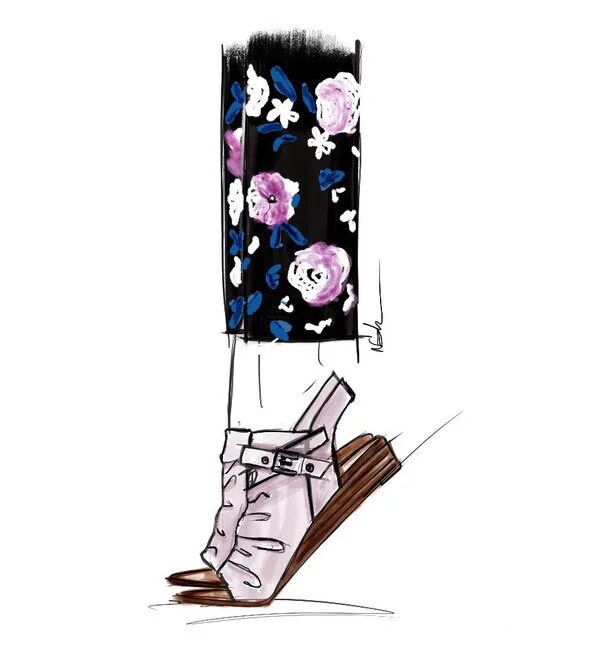Have you taken steps into the sustainable realm? Consider these options!
Illustration by Nalini Arora
Since I started designing shoes 18 years ago, it’s been primarily with brands using PU.
Price, margins, and sales were the drivers when designing shoes. Designing to as many trends possible, sampling these designs, and working with sales on buyer requests in order to make a sale was the way of life for many years. It’s a pretty similar process today, and dated I might add.
I am very aware that brands selling in the mid to low tier level that price is of utter importance. Who doesn’t want to sell a million pairs to a store? I get that it needs to be at the lowest price possible. How can a brand follow a sustainable model when stores want the the lowest price? It’s difficult to move away from what makes the company profits vs. creating earth friendly products. How do you find that balance?
It’s time for more companies to take a stand and provide a sustainable story within their business model. As brands, and people we owe it to ourselves, our neighbors, and the earth to do better. Our climate cannot afford the excessive carbon footprint from our traveling, sampling of shoes that have nowhere to go, but our oceans, or people dealing with eco-anxiety from our inability to change. We’ve got enough on our plate with viruses, and now our economy.
Customers are getting smart. They are educating themselves, or if they have kids, they are being influenced by the Gen Z’s to step up and make changes. The pressure to make the change is inevitable.
Not sure where to start? Here are a few ideas:
1. Hemp: If you’re working with canvas or printed textiles, consider hemp. Bastine has some beautiful options. If you can’t afford using a branded company, ask your supplier for hemp and organic options. I’m sure there are a tons of oversea options.
3. RPET (recycled plastics) Right before the shutdown due to Covid-19, I had the opportunity to attend the launch party for Blowfish’s 4Earth footwear. I was impressed by their use of water bottles for a capsule collection. It’s nice to see a brand at their price point take a step toward sustainability. I tried to find out which part was specifically sustainable. No one seemed to be able to give me that information. Nonetheless, I think it’s a great start. You can read more about it here. Recycled water bottle options can be found in textiles, meshes, hardware, and outsoles.
5. Dead stock material story : Maybe you can’t afford expensive materials of recycled water bottles and plant based. You can opt for finding materials that have excess stock, or cancelled materials from vendors. These can qualify as limited editions and/or each pair has a unique feature. Customers today want to feel that that what they’re getting is unique to them, and are more open to not getting what they see online if it’s clarified in the description.
5. Turn in the old for a discounted new: If you’re a brand who has a loyal fan base, and are repeat buyers, offer a discount for those who turn in their old shoes. This will not only create a more loyal fan base, it’s an incentive to buy something new with a discount. H&M takes in all apparel, and provides a 15% discount. It’s a great way to incentivize customers to come back, but also leaves you with a positive feeling of sustainability.
6. Packaging free: Let’s face it, most of us throw our boxes away. Consider offering shoes package free. A shoe bag for kid’s pencils? A tote bag for shopping? A recyclable water bottle gym bag for the man? Or just a bag for your shoes. Nonetheless, it’s less waste put out in the landfills and our ocean. It’s also a great way to promote your brand.
7. Less sampling thru 3D rendering: I recently worked with a sustainable shoe brand that preferred to take a proactive and sustainable approach to sampling. We worked with 4D shoe tech to create 3D renderings of upper designs, and outsoles. It’s a great way to see your ideas, and making corrections before sampling. I’m happy to make a connection. I don’t think they have a website yet.
This may all seem overwhelming, and impossible. Yes, it requires research, a creative team to brainstorm what works for your brand, trial and error, and maybe financial sacrifices in the beginning. I would think that saving our planet, animals, and people would be preferential, and maybe a bit idealistic. People are changing, and evolving, and taking stands on ways of living. Why not pivot towards it before a competitor beats you to it!




